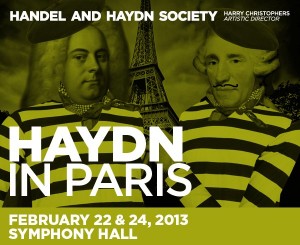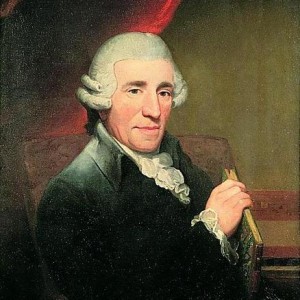Concert Review: Aisslinn Nosky and the Handel and Haydn Society/Harry Christophers
Handel and Haydn artistic director Harry Christophers placed a composer who is familiar but not always the focus of attention, front and center, and, in the process, reminded us just how good a musician Haydn was.
By Jonathan Blumhofer
At the very minimum, the Handel and Haydn Society (H&H) presents one all-namesake program each year (Messiah). But its other half, Haydn, doesn’t always get the stage to himself for an entire evening. To remedy this oversight (at least for this season) H&H’s program at Symphony Hall this past weekend was all-Haydn. Called Haydn in Paris, it showcased two symphonies, a violin concerto, and an opera overture, all composed between 1761 and 1786. In so doing, H&H and artistic director Harry Christophers placed a composer who is familiar, but not always the focus of attention, front and center, and, in the process, reminded us just how good a musician he was—and what we deprive ourselves of by minimizing his accomplishments: if anyone didn’t write a wrong note, surely it was Haydn.
The concert’s two curiosities came in the middle: the 1769 Violin Concerto in G and the overture to the 1779 opera L’isola disabitata. The latter, which recounts the tale of two sisters stranded on an island, is an essay in the Sturm und Drang style of Haydn’s prime, commencing with a slow introduction before launching into an appropriately storm-tossed main section. Christophers and H&H delivered a strongly etched realization of both halves, with a particularly violent depiction of its closing pages.
The Violin Concerto was originally written for the eighteenth-century virtuoso Luigi Tomassini, concertmaster of the Esterhazy court orchestra, where Haydn was employed for nearly 30 years. Overall, it’s a fairly straightforward work that foreshadows Mozart’s subsequent efforts in the genre, though it’s filled with winning tunes and plenty of opportunities for the soloist to show off.
This weekend’s soloist (doing double-duty in this work as leader of the ensemble) was concertmaster Aisslinn Nosky, and she proved a probing interpreter of this concerto, shaping the solo part with grace, color, and energy. Her colleagues in the orchestra followed her every step, wholeheartedly capturing the music’s charms, occasional quirkiness, and humor. Only in the brisk (and short) finale were there some small balance issues between soloist and orchestra; throughout, though, was a real sense of chamber music spontaneously coaxed to life.
Framing these pieces were the two symphonies, nos. 6 (Le matin—Morning) and 82 (L’ours—The Bear). Written a quarter-century apart, one might be excused for expecting an apprentice-like early effort in the genre. Sunday’s performance revealed anything but: this is a wildly inventive piece, featuring an array of instrumental textures, striking turns of harmony, characteristic Haydn wit and a novel approach to form that anticipates any number of things Beethoven undertook half a century later.
Christophers drew a lithe, energetic performance of the first movement, graciously shaping the crescendo that depicts the rising sun before flautist Christopher Krueger led the ensemble into the main business of the movement, with a lively account of its triadic, principle motive.
The second movement features quite the contrast. Beginning with a darkly unfolding chord progression that leads from the major to the minor, the music turns lightward with an extended dialogue between solo violin and cello before the clouds return at the end. Ms. Nosky and principal cellist Guy Fishman were Sunday’s fine and sensitive soloists.
While the third movement Minuet again showcased solo violin and cello, it was bassoonist Andrew Schwartz and principal bass Robert Nairn who stole the attention with their amiably galumphing account of the trio. In the finale, Haydn recalled some of the textures and gestures of the opening movement, lending the symphony a strong sense of arch form. Here, Christophers elicited vigorous playing and crisp articulation from the orchestra, which again called on various soloists (led by Ms. Nosky’s strikingly understated account of the virtuosic solo violin part).
The Bear (the title comes from the finale’s supposed resemblance to music used to accompany dancing bears at carnivals) was the first of six symphonies Haydn wrote on a commission from the Parisian Claude-François-Marie Rigolet, the Comte d’Ogny. While Le matin revels in sheer freshness and invention, L’ours is somewhat more restrained, the work of a composer who knows how to say more with less.
As in the earlier symphony, H&H’s playing in the opening movement of Symphony no. 82 was vital and energetic, enhanced by the inclusion of timpani (vigorously realized by John Grimes) and extra brass (trumpets and horns, instead of just the horns of Le matin). The second movement, a classic set of Haydn variations, features a tune of such Beethovenian simplicity that the breadth of its ensuing development—from naïve to yearning to stormy to playful—remains astonishing. These various character shifts were the focus of Sunday’s performance, and it was gripping to hear playing that so married intensity and sensitivity.
The charm and humor of Haydn was fully present in the third movement Minuet, with its unexpected turns of phrase, and, even more, in the finale. In this last movement, which begins with a soft drone that builds to sound (on Sunday, at least) like a wailing bagpipe, Haydn demonstrated a tremendous amount of sheer compositional craftsmanship, but none of his technique ever gets in the way of the music. A couple of brass slip-ups aside, this was simply a terrific performance: Christophers maintained a firm grasp on the proceedings, but he stepped back to let the inner parts come out and gamely interact with one another. The false endings (and what is a Haydn symphony without a false ending or two?) drew knowing laughs, proving that, less than 20 years from his tercentenary, the Old Man still’s got it—and we’re the better for it.
Tagged: Aisslinn Nosky, Handel and Haydn Society, Harry Christophers


